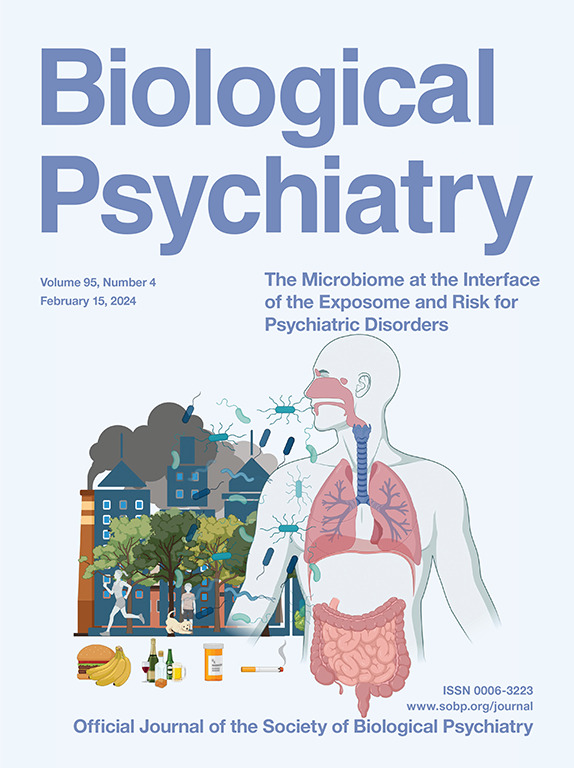用 Omics 方法研究自杀的发病机制。
IF 9.6
1区 医学
Q1 NEUROSCIENCES
引用次数: 0
摘要
自杀是美国青少年和年轻成年人的第二大死因,通常与精神障碍有关。自杀行为的病因和发病机制十分复杂。适度的遗传性表明是由遗传因素引起的。童年和近期生活逆境之间的关联表明表观遗传因素对自杀有影响。基因组对自杀发病机制的影响在很大程度上仍然未知。本文基于一个研讨会,该研讨会旨在制定策略,以确定自杀神经生物学的分子驱动因素,并将其作为新的治疗目标。小组认为,虽然大块组织研究能提供全面的信息,但还需要单个细胞核方法来确定细胞类型的特定变化。单核技术缺乏细胞质、过程、脊柱和突触方面的信息,而完整组织的空间多组学技术则能检测到脑组织层和亚区域的特定细胞变化。由于自杀有遗传和环境驱动因素,多组学方法结合了细胞类型特定的表观基因组、转录组和蛋白质组,可提供更完整的发病机制图谱。为了确定自杀风险基因变异对 RNA 和蛋白质表达的影响方向,以及这些变异如何与表观遗传标记相互作用,应将单核和空间多组学定量性状位点图与全基因组测序和全基因组关联数据库结合起来。研讨会最后建议成立一个国际自杀生物学联合会,汇集脑库和在前沿物联网技术方面具有专长的研究人员,以阐明自杀生物学,确定新的潜在治疗目标,并在细胞和动物模型中进行测试,以发现药物和生物标志物,指导自杀预防工作。本文章由计算机程序翻译,如有差异,请以英文原文为准。
Omics Approaches to Investigate the Pathogenesis of Suicide
Suicide is the second leading cause of death in U.S. adolescents and young adults and is generally associated with a psychiatric disorder. Suicidal behavior has a complex etiology and pathogenesis. Moderate heritability suggests genetic causes. Associations between childhood and recent life adversity indicate contributions from epigenetic factors. Genomic contributions to suicide pathogenesis remain largely unknown. This article is based on a workshop held to design strategies to identify molecular drivers of suicide neurobiology that would be putative new treatment targets. The panel determined that while bulk tissue studies provide comprehensive information, single-nucleus approaches that identify cell type–specific changes are needed. While single-nuclei techniques lack information on cytoplasm, processes, spines, and synapses, spatial multiomic technologies on intact tissue detect cell alterations specific to brain tissue layers and subregions. Because suicide has genetic and environmental drivers, multiomic approaches that combine cell type–specific epigenome, transcriptome, and proteome provide a more complete picture of pathogenesis. To determine the direction of effect of suicide risk gene variants on RNA and protein expression and how these interact with epigenetic marks, single-nuclei and spatial multiomics quantitative trait loci maps should be integrated with whole-genome sequencing and genome-wide association databases. The workshop concluded with a recommendation for the formation of an international suicide biology consortium that will bring together brain banks and investigators with expertise in cutting-edge omics technologies to delineate the biology of suicide and identify novel potential treatment targets to be tested in cellular and animal models for drug and biomarker discovery to guide suicide prevention.
求助全文
通过发布文献求助,成功后即可免费获取论文全文。
去求助
来源期刊

Biological Psychiatry
医学-精神病学
CiteScore
18.80
自引率
2.80%
发文量
1398
审稿时长
33 days
期刊介绍:
Biological Psychiatry is an official journal of the Society of Biological Psychiatry and was established in 1969. It is the first journal in the Biological Psychiatry family, which also includes Biological Psychiatry: Cognitive Neuroscience and Neuroimaging and Biological Psychiatry: Global Open Science. The Society's main goal is to promote excellence in scientific research and education in the fields related to the nature, causes, mechanisms, and treatments of disorders pertaining to thought, emotion, and behavior. To fulfill this mission, Biological Psychiatry publishes peer-reviewed, rapid-publication articles that present new findings from original basic, translational, and clinical mechanistic research, ultimately advancing our understanding of psychiatric disorders and their treatment. The journal also encourages the submission of reviews and commentaries on current research and topics of interest.
 求助内容:
求助内容: 应助结果提醒方式:
应助结果提醒方式:


